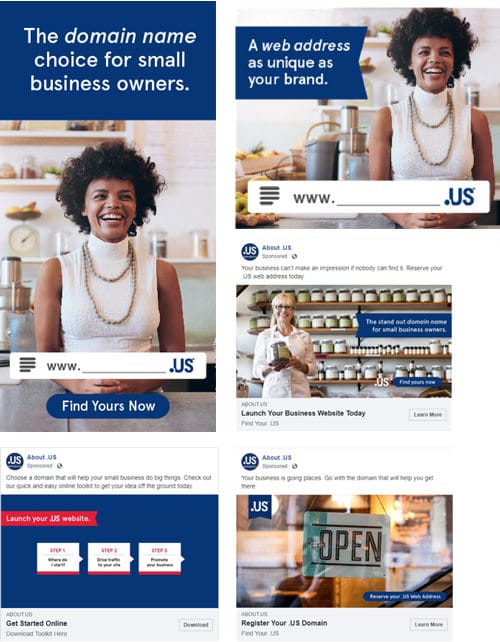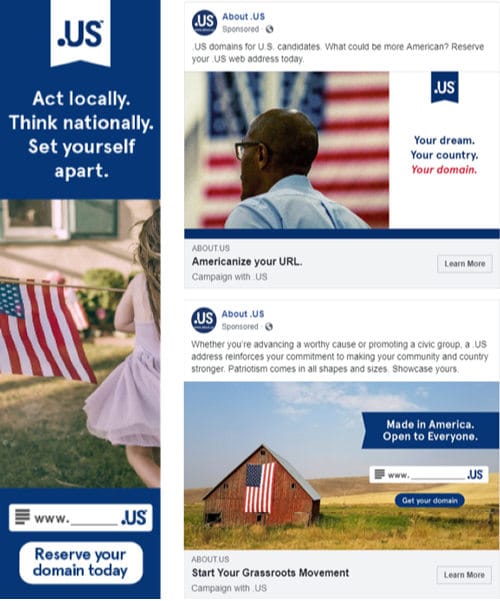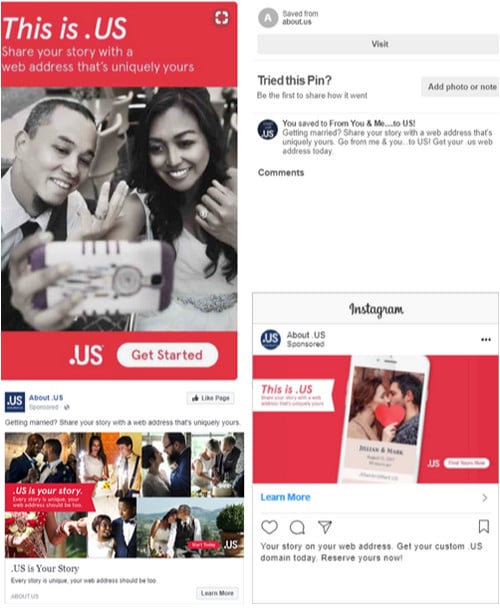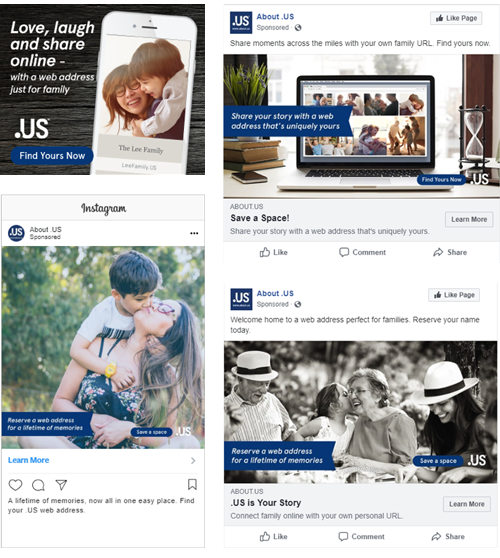[Editor’s note: This is a sponsored post by Lori Anne Wardi of Neustar]
Hi, my name is Lori Anne Wardi and I’m a domain junkie.
I’ve been buying, selling, studying, developing, dreaming about, promoting and preaching the bible of domain names since 2000. With many years as a domain investor under my belt, I got the opportunity to join the founding team of .CO Internet in 2009 as the Director of Marketing. From 2010 through today, it has been amazing to watch .CO grow from 28,000 domains under management to well over 2.2 million – and become the domain of choice for many of the world’s leading innovators, entrepreneurs and startups.
In 2014, when .CO Internet was acquired by Neustar, this born and bred New Yorker was given the chance to serve as the General Manager for the launch of New York City’s .nyc domain. Working with the Neustar team to help turn the greatest city brand in the world into the one of the greatest city TLDs in the world was beyond rewarding, amidst all of the excitement and novelty of the new gTLD program.
Launching a brand and building a community around a domain extension is the best kind of challenge – it pushes your creative and strategic brains at the same time and forces you to think outside the box. But not every domain extension has the luxury of starting with a blank slate. Let’s take the .US domain, for example. With 17 years under its belt, it’s hardly a brand new, baby namespace. So exactly how does a teenage TLD, like .US, stand out in a marketplace with more than 1,000 shiny new competitors?
Keeping .US fresh after 17 years
I know that the topic of .US marketing has occasionally inspired some very, shall we say, “spirited” commentary by domain investors. I mean, I read all the domain blogs too! I get it, and it’s for good reason. As investors, we want to know that the TLDs we invest in are being well managed and marketed, and are building an engaged, loyal customer base of end-users in today’s increasingly crowded and complex marketplace.
After 17 years as the .US Administrator, there are a host of different strategies and tactics that Neustar’s marketing team uses to keep .US fresh, relevant and in demand by end-users. I could rattle on about how we use things like programmatic advertising, paid search, influencer marketing, retargeting, content marketing, and the like. But don’t worry, I won’t bore you with all the gory details. My goal today is just to give you a quick flyover view of our approach to defining and engaging with the .US target market.
’Micro-targeting’: The many faces of .US
It is marketing 101 that you need to clearly define your target market for any product, service or brand. As the country code domain extension for the United States of America, our most obvious end-user target market is, you guessed it, American businesses, organizations and individuals.
While “Americans” are obviously a cornerstone of our marketing, if our marketing whizzes had just written “America” next to “target audience” and patted themselves on the back for a solid day’s work, I suspect our marketing campaigns would go over like a led balloon. Luckily, that has not been the case.
Instead, our team has developed a ‘micro-targeting’ approach; essentially, breaking our audience down into niche segments that each have unique and interesting motivations for using .US domains – and then building creative, relevant campaigns for each of these groups.
Some of these groups are attracted to the national pride and patriotism of the .US domain, others we’ve reached by thinking laterally about the TLD and leaning into the use of the word “us” to build special campaigns to represent community, connection and relationships.
More than just registrations, the ultimate goal of our micro-targeting is to ensure that there is genuine, meaningful usage of the .US domain, which ultimately is one of the best barometers for domain registries in assessing the health and viability of any namespace. Here are just a few examples of the unique end-user target markets we engage with as part of the .US community.
Small businesses – Dream with .US
SMBs in the USA are the bread-and-butter for .US domains. More than just a domain, .US supports small and medium sized businesses with tools and resources to help business owners launch and manage their websites, including step-by-step guides on topics ranging from choosing a domain, to lead generation, to social media and SEO. To spread the .US message to SMBs, we participate in a variety of business focused tradeshows and events, and leverage popular promotional channels like podcast advertising, social media and search engine marketing, among other things.

Political & civic engagement – Campaign with .US
Democrat or Republican, liberal or conservative, or everything in between, for political candidates, advocates and activists in the US of A, the .US domain is clearly a perfect match. Our “Campaign with .US” initiative helps these highly-engaged and passionate people and groups connect their cause(s) with their country through a .US domain. Since there are so many options available for ad targeting based on job title, group association and user search history that indicates political involvement, we have the opportunity to be hyper focused in our approach and deliberate in our messaging.

Engaged couples – This is .US
One example of how we have used the concept of “us” to market the .US domain is by tapping into the wedding website market. Our “This is .US” campaign encourages newly engaged couples in the United States to create their wedding website on a .US domain, and to grow their website as their relationship and family develops. There is a wealth of behavioral and interest targeting data available to identify those preparing for an upcoming wedding, so we can be sure to reach the right people at the right time with our message.

Families – Thankful for .US
Again, emphasizing the word ‘us’, our “Thankful for .US” campaign encourages American families to secure their personalized family web address on .US domain. A family web address can be a place to share your family story or a platform to keep in touch with long-distance or extended family members whether through building a website or creating a family email group. There’s a strong case that family websites and emails are more personal, accessible and private than many popular social media sites, which let’s face it, are increasingly being criticized for harvesting our personal family data in sometimes mysterious (and often unwanted) ways.

The Story of .US
At the end of the day, the best kind of marketing is the kind you don’t do yourself: word of mouth. Building a sense of community, ownership and loyalty around the .US domain enables us to let our satisfied customers tell their stories — promoting .US in the process.
Our recent “Story of .US” video campaign featured real .US customers from a wide array of backgrounds showcasing their businesses and brands – and explaining their affinity for the .US domain in their own words. From the multi-billion dollar tech behemoth Zoom.US, which just had the most successful IPO of 2019, to a group a high-schoolers who have started their own web development business — it’s extremely gratifying for us to see and hear real customers enthusiastically sharing their .US stories with the world.
Please take some time to watch some or all of the videos in “The Story of .US” campaign – you can find some of them below, or all of them on our website here. We are extremely proud of this campaign and hope you find it inspiring too.

The next 17 years and beyond
It has been an honor for the Neustar team to launch, build, grow and shape the .US namespace, from inception to today. But we’ve never rested on our laurels and we certainly don’t plan to do so now. In the years ahead, we are committed to continue refining our marketing strategy, innovating on new and unique marketing campaigns, engaging our community of brand ambassadors and supporting ongoing growth and success of the .US TLD.
Ultimately our goal is to ensure that the millions of individuals, businesses, non-profit organizations, community groups, couples, families, startups, solopreneurs, veterans, dreamers, makers and more who are building their future on .US – as well as those who invest in the .US namespace – can rest assured knowing that .US is one of the most trusted, dynamic and in demand TLDs in the world.
If you know of any cool .US customers, or stumble upon any “in the wild” – please reach out and let us know. We are always looking for new and interesting ways to shine the light on the great things happening in the .US namespace! You can learn more about .US at www.about.us, and can contact us [email protected]. Thanks for reading!






brilliant… truly.
Im a fan of tld marketing, best piece i’ve seen in years
but no surprise, thanks for sharing Andrew and Lori for Producing.
page Howe
.us has been a disaster, no market, no usage, no place. Good luck trying to sell that extension to domainers.
Prove your claim with an authoritative source or desist from spreading malicious libels.
Just about everyone knows .us has been a failure, we are .com in the USA, we invented the internet (even Al Gore is American if you believe in his claims). Let the Brits and Germans use their .uk and .de to set them apart from the standard and original american made .com.
Maybe long-term .us might gain some ground, but we aren’t there yet.
There is a market for .US ccTLD and there is usage. (I ran a usage comparison against .EU and .US some time ago.) However, the position of .COM in the US market means that a lot of .us registrations are brand protection registrations. This is quite different from the usual case with strong ccTLDs where the ccTLD is the primaryTLD in that country’s market. In terms of marketing, ccTLDs are a lot more complex than a gTLD with a global market. The dynamics of ccTLDs (and even .NYC and some of the other geographic new gTLDs are types of pseudo-ccTLDs rather than gTLDs) can be domainer adverse in that domainers using .COM rules to register domain names beyond the core group of high quality generic keywords can lose money. With successful ccTLDs, the extension becomes invisible to its users because it is “their” ccTLD. Getting the registrants to think of their country’s ccTLD in this manner takes time and a lot of marketing. Increasing the usage and development percentage is going to be a tough task for Neustar. The danger is that .US ccTLD will, due to the high level of brand protection registrations, become a kind of Truckstop TLD where people go before being redirected to the registrant’s primary website in .COM. A well marketed .US with strong local adoption and visibility could have around 50 million registrations.
Thanks for your efforts!
I invest in both .com and non-.com domains. And I think people’s choices of TLDs becoming more diversified is really a great thing.
Fantastic Article Lori Anne. The great thing about domain names is it’s been proven over and over that it’s not just a .com world.
Extensions like .co, .us, .me – more recently .ai.and .io – are continually getting more and more adoption by both local and global companies. From Angel List to Zoom, thousands of brands we all know today started and/or still operate on non .com extensions.
Neustar has been a cornerstone of the Internet for a long time and the commitment your team shows to creating adoption and providing many companies (and people) the opportunity to brand themselves in a very meaningful short fashion is critical to the overall growth of the domain name industry – Yes .com owners, how extensions like .us and .me succeed is directly relevant to the value of your .com’s.
Keep up the great work!
Any plans to support emoji domains on .us?
Under what circumstances would you recommend someone to start with a .US over .Com?
If you are an American company that does most of its business overseas, or if you are couple getting married and want a website for you wedding.
Can you elaborate?
ccTLD domains are favored by search engines in a local search, so if you are a small-medium size local business you will benefit more from .US domain name as your search ranking will be improved.
On the other hand if you are a global business, then they both have “same strength” from a pure SEO point-of-view.
Especially if you are a small “brick-and-mortar” business, you will benefit more from .US domain.
Do you have any links to support those claims?
No, no, no – please stop referencing Zoom.US as one of your success stories. It is most certainly not. I suspect that name was a huge liability for them, probably responsible for tons of lost traffic and email. While it may be true that they had a successful IPO, you coveniently forgot to mention that the first thing they did with their new funding was to upgrade to the .COM to stop the traffic leaking.
From .CO to .NYC to gTLDs to .US, it seems clear to me that you specialize in selling .MUD which then makes you a modern day snakeoil saleswoman. Tsk, tsk. Hope you can sleep well at night. I would not be able to.
Who the f wants to type in blah blah blah dot US…
Intuitively, all roads lead to dot com
Hey, I guess you have to justify your job$$$$
Gotta agree with Snoopy on this, no enduser desire.
Well Lori, if you get too good at this they may need to get rid of you.
> “So exactly how does a teenage TLD, like .US, stand out in a marketplace with more than 1,000 shiny new competitors?”
One of the greatest ironies of .US is that it was released for public use – under a rock, that is – at the very pinnacle of the greatest resurgence of US patriotism virtually every living person in America has ever seen in our lifetime and quite possibly will ever see. The only rival period for such patriotic renewal would doubtless be WW II.
In the Wizard of Oz, Dorothy struggled through the entire movie just to make her way home. We struggled with her through all her wild and dangerous adventures. Finally she and all of us discovered the ironic revelation, that she was carrying the answer herself entire time.
.US is exactly like that famous story we all grew up with here in the USA. From Day 1 in April 2002 – and every single day since to this day – there has never been any mystery or riddle about what could have and would have lit the flame of public awareness, popularity and passion – virtually without even costing a single penny, and scarcely even having to lift a finger.
For Dorothy it was the ruby slippers and the homeward incantation.
For US it has been a no-brainer the size of the USA itself. For us it is and has always been, and for the sake of efficiency in phraseology, the “PTB.” In a manner of speaking, virtually a single word, and virtually a single use by example is all it would have ever taken. Even Christian Zouzas, the most famous .us domain “investor” of them all, sees it and has been saying more or less the same thing on his Twitter page in recent months.
Had the “PTB” of the USA not wanted to release .us under a rock as it was in April of 2002, and had really wanted it to go anywhere, they would have done and could always still have done the exact opposite of what they all have done ever since. The President and other prominent US government figures would have said even just a single word to the American public, and begun using it in various ways. Most ironically, and tellingly, of all – would have begun transitioning certain prominent US entities to the ultimate no-brainer patriotic TLD instead of keeping them on .com.
One of the most incredibly glaring and astronomical examples of .US-avoidance has always even amazed me.
I don’t watch much television anymore, hardly any really, but in the years since April 2002 there was a period of time in which I used to watch a fair amount. One of the most captivating and patriotic marketing campaigns – and one of the greatest platforms one could ever imagine for getting the American public to even know that .US exists at all, as well as ignite the fire of interest – has always been the television ad campaigns of the US military. Genuinely engaging and spectacularly engrossing examples of patriotic captivation for anyone and everyone with even a streak of the red, white and blue in them, even those who only wished they could have served some time in the US military but for various reasons they could not. And every single time, at the great and final climax of these presentations – the viewer is solemnly presented with “.com” instead of “.us.”
How incalculably ironic.
One of the greatest spectacles you could possibly even imagine to demonstrate American patriotism on the Internet aside from statements and actions of the “PTB” to begin with about .US, yet nothing. Nothing but the “.com” establishment and status quo glaring brightly like the noonday sun.
And that is only one such example. As it is, these 17+ years later the American public still for all intents and purposes practically doesn’t even know that .us exists at all, period.
And the idea some have that the burden lies with the Neustar registry itself to bring about incrementalism over decades and decades is disingenuous at best, and much worse than that at worst. If whoever has occupied the relevant positions of authority had ever wanted the American public to be substantially aware of America’s own online country code and for it to go anywhere at all since Day 1 in 2002, things would and could – and should – have been very different.
> “I mean, I read all the domain blogs too!”
Well perhaps you’ll like my other recent related comments too. Especially the one where I mentioned I had worked in both US federal law enforcement and IT before.
> “As investors, we want to know that the TLDs we invest in are being well managed and marketed, and are building”
> “As the country code domain extension for the United States of America, our most obvious end-user target market is, you guessed it, American businesses, organizations and individuals.”
> “Instead, our team has developed a ‘micro-targeting’ approach; essentially, breaking our audience down into niche segments that each have unique and interesting motivations for using .US domains – and then building creative, relevant campaigns for each of these groups.”
Sounds great, doesn’t it? And some of the activity even looks pretty nice. But piecemeal incrementalism is a nowhere strategy, and certainly not appropriate for something as significant as .US.
A blogger named Caitlin Johnstone, probably not known to most in the domain industry, is one of the great “truth seeking truth tellers” of our time. She wrote a great blog post only days ago about “Why “Incremental Change” Is Worse Than No Change At All,” and people should take a look at that post and then contemplate this very issue in comparison to that (https://caitlinjohnstone.com/2019/07/15/why-incremental-change-is-worse-than-no-change-at-all/). Other truth tellers and truth seekers have recently covered very well the same idea as well.
> “It has been an honor for the Neustar team to launch, build, grow and shape the .US namespace, from inception to today. But we’ve never rested on our laurels and we certainly don’t plan to do so now. In the years ahead, we are committed to continue refining our marketing strategy, innovating on new and unique marketing campaigns, engaging our community of brand ambassadors and supporting ongoing growth and success of the .US TLD.”
And as mentioned above, the American public still scarcely even knows that .US exists at all. Practically speaking, despite a little bit of progress since 2002 – they still don’t know.
> “Ultimately our goal is to ensure that the millions […] are building their future on .US – as well as those who invest in the .US namespace – can rest assured knowing that .US is one of the most trusted, dynamic and in demand TLDs in the world.”
Well Lori perhaps even you can agree that ending assessment of the current state of things there is getting a bit carried away, but frankly we know that it’s your job, and we all understand the idea of commercial puffery and the like, so it can certainly be overlooked.
But that is not the main reason why I quoted that.
The main reason why I quoted that resides with this: “as well as those who invest in the .US namespace.”
Many have invested over 17 years of their time, money and life in .US now, but aside from all the other issues, which are huge, there is also looming a practical “existential threat” to .US and to all that nearly 20 years of such investment of time, money and life already. And it remains to be seen whether Neustar and the “PTB” are going to allow (or worse) this practical existential threat to have its merry way.
And that practical “existential threat” is .USA.
The push for .USA apart from .US is one of the greatest travesties and mockeries in TLDs and specifically of .US one could ever even imagine, and directly and completely threatens all of the years of time, money and life others have already invested in .US. Not to mention Neustar’s own interests if it is indeed true that Neustar has any interests at all.
And don’t misunderstand me: I am a patriotic American, bounding the Internet super highway in shades of red, white and blue. Nothing would please me more than to see a .USA alongside .US – but only if it is done properly and right – only if it is done in a genuinely American way. So what does this mean?
The only way of .USA existing and being released to the public at all that treats the investment of time, money and life people have already spent on .US these 17 plus years now with justice and fairness is to: 1. recognize what it really is, i.e. a country designation, in this case an alternative to the first .us iteration. Say what one will about how ccTLDs can only be two letters – either an exception should made for .USA or it should not exist at all, unless and only unless its existence conforms to: 2. The fair and right thing to do if .USA is even to be allowed to exist and be released at all is if it is done exactly as has already just been done in the case of .UK. Yes, that means:
1. First right of registration for .US holders of corresponding SLDs.
2. NO public gouging premium costs, no matter how good the domain is – just as .US was released originally and still is and should be. Simple basic “reg fee” for all domains, especially for those who already have the corresponding .US.
Anything less makes a total mockery of .US itself and all the people who have spent and invested so much into it all the way since 2002 to this very day.
I’m sure there is more I could address, but for now I will close with this:
PRIVACY – whois
As I mentioned before, not only did I once work in US federal law enforcement, but in the reinventing of oneself many of us experience in our lives, I also worked professionally in IT, and especially with data and database technology.
There is NO excuse – none, zero, zilch, nada – for American citizens and American businesses still not having the right and option of engaging in whois privacy after all these nearly 20 years. This was *already* the case in April 2002, is even more so now in 2019, and has been increasing in significance and importance every year in between. It is nothing but data in a database, and there is both no practical excuse and no other excuse of any kind. While I’m sure exceptions may exist for instance, even the nexus requirement itself for all intents and purposes doesn’t get enforced no less, but there is no meaningful practical impediment to data access to begin with for issues anyone in appropriate positions might actually really care about – nor has there ever been.
The entire world no less has continued to increasingly recognize and even expand the importance and right of privacy since 2002, particularly and especially for domain TLD whois, while .US has continued to preserve the undesirable status quo. It should go without even mentioning that it is obvious to anyone this lack of such a privacy option also works against the very kind of adoption and use people purport to want and work for and support. Not allowing Americans to engage in this in today’s world is even nothing less than appropriately called obscene.
According to Konstantinos Zournas at OnlineDomain.com, who attended the 2017 .US Town Hall –
“Neustar said that they are working on the whois privacy implementation for .us domain names. That was never allowed up to now, mainly because of the Nexus requirements. Only US residents and US organizations and companies that have a bona fide presence in the United States of America can own a .us domain name.
According to Neustar that has been their biggest policy issue to date. The Council formed subcommittees, solicited public comment and worked with law enforcement (?) and other stakeholders to build a consensus recommendation. It seems that .us whois privacy may be introduced in 2018.”
2018 came and went, and here we are with half of 2019 already spilling into 2020. I think the time for talking about it is over, don’t you think?
So Dorothy could have made her way home in an instant any time she wanted, but she never knew. In this case, however, we do know, and have always known. Incrementalism is often a counterproductive and even harmful path. The burden is *not* on the registry, contrary to the misguided public narrative and misconception about that. .USA should not be allowed to exist unless and only unless it is done fairly and equitably with regard to the many who have invested so much for so many years in .US. And in a no-brainer the size of the .US itself, American citizens of all people and American businesses must have the right of .us whois privacy to use or not use at their discretion in today’s society.
Supplemental items re the above, the approaching .USA behemoth that would eat up .US and everyone’s near 20 investment in it:
1. Main site: http://www.dot-usa.info
2. FB: facebook (dot) com/dotusa/
3. T: twitter (dot) com/dot_usa
near 20 year*
It makes a great domain back but with so many gltd’s it’s a hard sell, the it one I’ve invested in is dot site for gambling domains as it seems to fit.
There are still numerous issues with the .us namespace. First and foremost is the fact that most Americans are unaware that .us is the countrry code domain extension for the United States. It’s (.us’s) initial usage as a government/locality extension kind of made it difficult to sell it as a viable platform for actual business websites. The kids.us venture was another distraction.
Why is it that if you seek to register a domain name at almost any major registrar, if your search term is not available in .com, the suggestions for alternative extensions never contain the availability of the .us term. Do other extensions pay a premium for this preferred placement of suggestions? Just wondering. For example….. how did .co become so accepted so quickly?
Why not promote .us as a “safer” place to do business, and then make it so. Any business done within a .us domain would be within the bounds of U.S. laws. Many .com domains, and others, are owned and operated worldwide and it might be more difficult to resolve business issues there.
Or……. take the exact opposite approach and open up registrations of .us to everyone worldwide and allow non – U.S. based businesses to break into the market. The perception of being within the United States market holds some weight. Whether actual weight or merely perceived, there would be interest.
Just some thoughts.
Garbage, paid for nonsense propaganda from a respectable blog. Not a good look at all. Definitely a step in wrong direction. Trust is hard to build and easy to lose.
Even if that is how you feel about this, and even if there are a few elements of propaganda in the post, the good news is that it got me to write and publish what I did above. 🙂